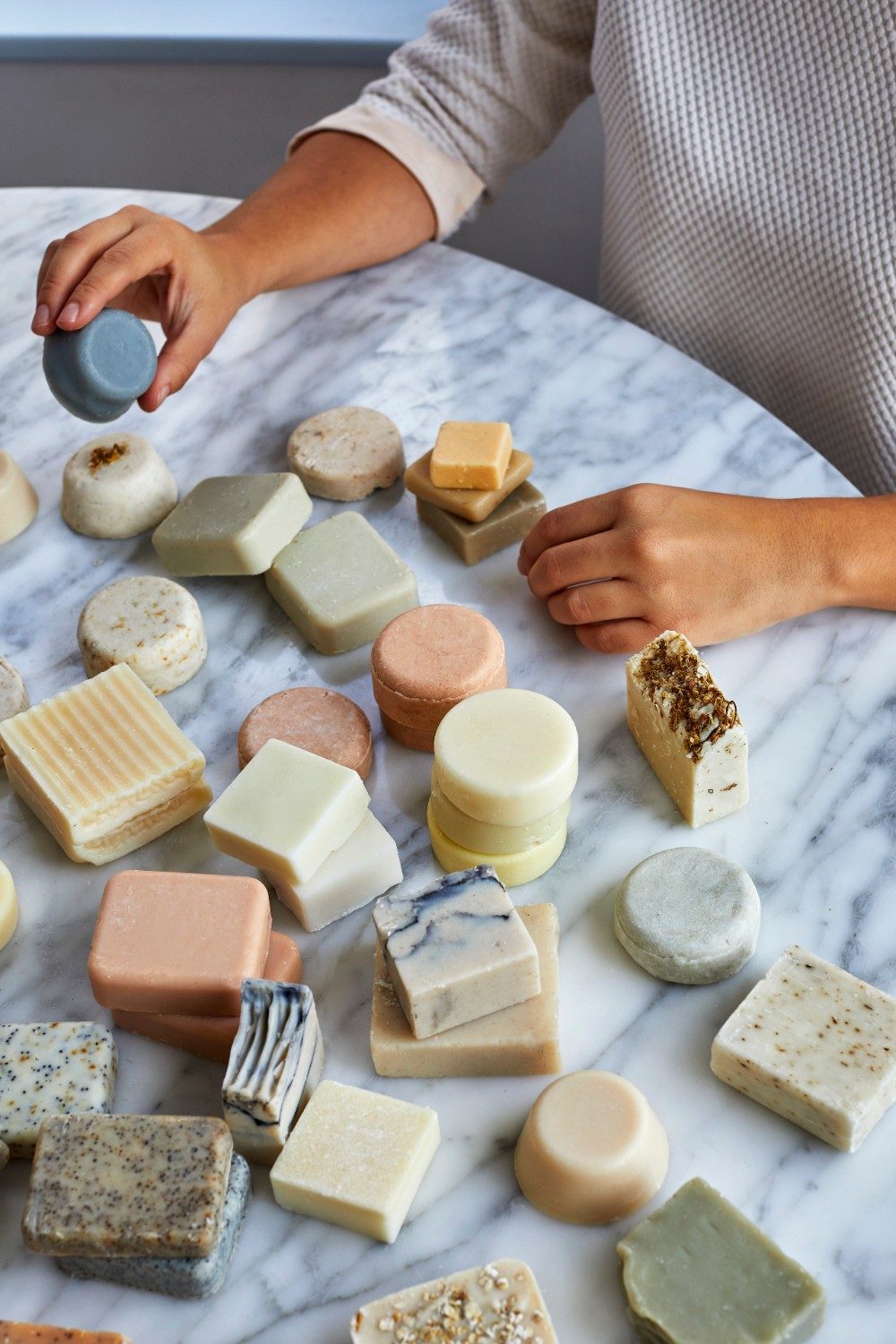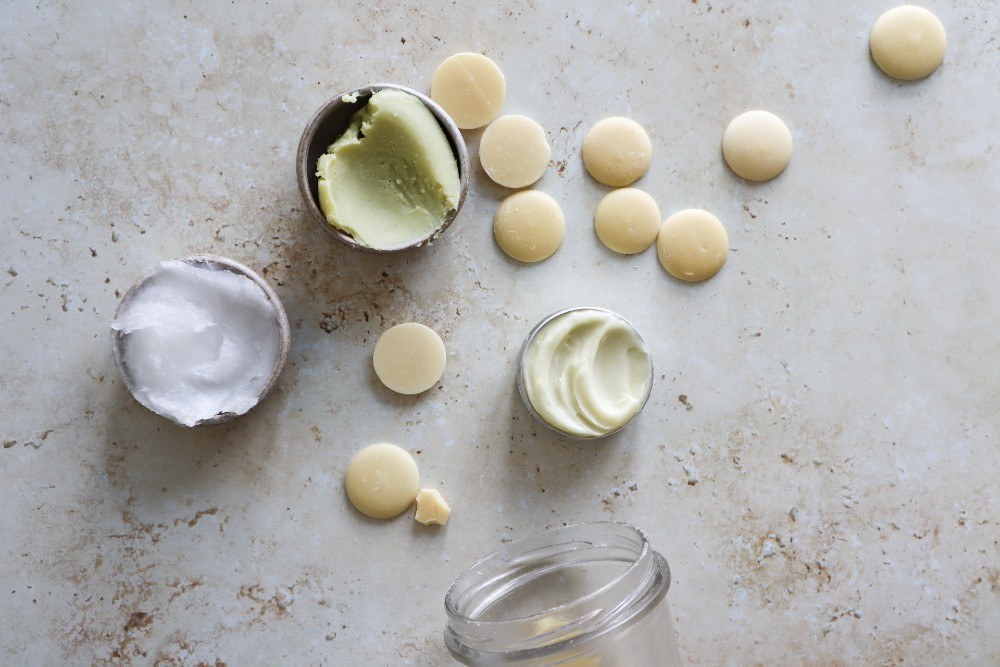Overwhelmed by all the plastic in her life, Marta with Bottega Zero Waste started looking for more eco-friendly alternatives. One of the first things she tried was cold process soap. She now makes beautiful bath products with simple and sustainable ingredients. You can find her recipes in her new book, Botanical Soaps: A Modern Guide. Get to know Marta below!

How long have you been making bath and beauty products, and how did you get started?
I started making my own products in 2018. Back then, I really felt like my life was filled with plastic. I thought about what feasible swaps I could make to simplify and declutter my life, and there it was: soap. Despite using it every day, I soon realised I did not know how soap was made! How was that even possible? I had to find out more.
I found a simple coconut and olive oil soap tutorial on YouTube and made my first ever soap bar. Too bad the recipe made over 3 kgs of it! It took me years to use it all. I still have one soap left from that batch and it still smells like jasmine and sandalwood. From there, I dived deeper into the world of soap making: Soap Queen’s blog was my go-to reference!
What do you love most about making bath and body products?
I love being able to control exactly what ingredient goes into each product, on my skin, and the planet. It feels incredibly empowering!
What inspires you to create?
Simplicity. My goal is to create products that are functional yet simple, each made with only a few essential ingredients. This minimalistic approach has allowed me to make natural products that actually help to reduce waste and genuinely benefit the skin.

What advice would you give to someone who wanted to get started?
When you start it's really easy to get sidetracked, and you’ll want to get your hands on every single natural ingredient you come across, all at once! While it's great that you’re curious, and experimenting is a necessary step in the learning process, my advice would be: keep it simple and learn with the help of a trusted guide.
Who’s another maker you admire? What do you love about their work?
I have always admired Ariane from La Fille de la Mer. I watch all of her YouTube videos! I adore her simple techniques and experience in handling large batches of soap.

Can you tell us a little bit about the process of writing a book?
Of course! As Botanical Soaps is a recipe book, the first step is formulating. I spent a good three months beavering away in my kitchen, formulating different recipes that could suit a beginner as well as someone who is more experienced with making products.
Then there was scripting: that took about five months. which included an initial draft. Thankfully I had an amazing editor and editor writer, who supported me until the end. They showed great patience and direction! After all the recipes had been scripted, we moved on to the styling and photoshooting phase: this was so.much.fun! We toured around three different London locations and I made small batches of the products to photograph each different step. All the locations were real houses and I could not get my head around the beautiful vintage interiors and amazing lighting that lit up every countertop.
The last step before the book went to print was a couple of months dedicated entirely to designing and proofreading. From putting together the book layout, to having beautiful botanical elements hand drawn by a talented illustrator, doing a million checks to make sure every recipe amount is spot-on, and checking there were no typos in the book. All of this could not have happened without such an amazing team!
What were some of your favorite parts? Were there challenges as well?
My favorite parts were, without a doubt, the formulating and the photoshooting stage. These were the parts that allowed me to express and shape exactly what I had in mind for Botanical Soaps, and I have learned so much along the way. There were of course challenges. One was to have confidence in myself and as well as my recipes: you want everything to be perfect! The testing cycle feels like it’s never-ending, I often found myself going back to the original formula.

Have you experienced a fail? How did you work through it, and what did you learn?
Yes, definitely! Especially when I transitioned from making products in small batches just for myself, to making products in larger batches to sell. Making five soaps versus 50 is really different, and I had quite a lot of soda ash nightmares to deal with.
Practice and applying the right techniques helped me improve and avoid making the same mistake twice. Another failure that comes to my mind was the first time I hosted a livestream soap making workshop. Even though I had made a small batch, I remember my lye simply would not cool down! I had to improvise a good 20 minutes of extra live content while my boyfriend kept checking the lye temperature for me behind the scenes. It was hilarious and a bit nerve-wracking at the same time. From these experiences, I have learned that soap making can be so unpredictable!
What plans do you have for your business moving forward?
I am planning to focus more on the online education side of my business, and less on the manufacturing side. I enjoy supporting new makers and students throughout their making journeys! I want to continue hosting my current soap and shampoo bars courses (you can find them at learn.bottegazerowaste.com) while always improving my students’ learning experiences. In the future, I'd also love to create a new course focused just on marketing your handmade and sustainable products business.

Body butter made with Bramble Berry hemp butter
Marta's top Bramble Berry picks
- Cocoa butter - I love cocoa butter because it's such a versatile product that I use in soap making, shampoo bars, lip balms, and body balms. I love the wafer format that Bramble Berry carries because each chip is so easy to crack in smaller bits to make smaller batches. Instead, the blocks of cocoa butter are usually so hard and brittle to cut, which usually results in more mess and wasted product.
- Arrowroot powder - Arrowroot powder is a staple in my making kitchen. It is lightweight and so versatile, I love adding it as a thickener in shampoo bars, as well as making products, such as body butters, less greasy.
- Rice bran oil - Rice bran oil is an absolute must for me in soap making, as well as in many skincare and hair care recipes. It has such a unique fatty acid profile, making the soap harder without losing its soft and silky lather. It’s light, yet it feels so nourishing, which is perfect for oil cleansing, lip balms, and shampoo bar recipes.
- French green clay - French green clay is one of the most versatile clays which I use in soap making, shampoo bars, and facial masks. Ironically, green is always such a hard color to obtain naturally, as any green powders usually fade to brown when exposed to light. With green clay, I am always mesmerized at how well its natural color sticks, particularly in handmade soaps! I have a soap I made three years ago and it's still as green as day one. It's truly incredible.
What’s the first Bramble Berry project you tried?
One of the first soap projects I tried was the Gentle Oatmeal Baby Soap with colloidal oatmeal and bentonite clay. It's incredible how the chamomile infusion holds its wonderful scent even in the final soap.
Another project I loved was the Lingonberry Spice Soap: I became so intrigued with the charcoal design and decided to give it a go. I surely smudged the charcoal lines a bit, but the result was still pretty good. Lather-wise, it turned out to be one of my favourite soaps to use!

Find Bottega Zero Waste
Online
Instagram
Facebook
YouTube

